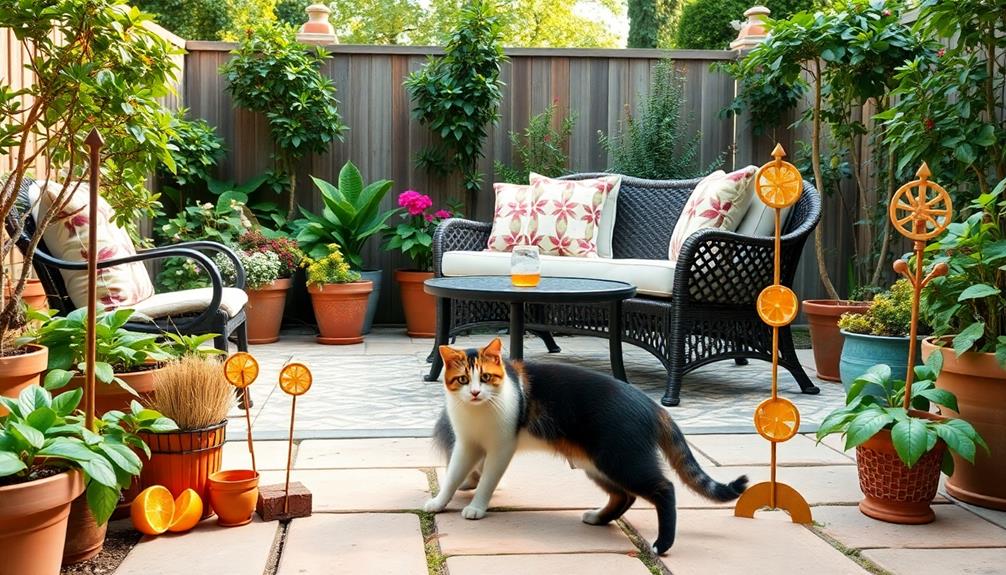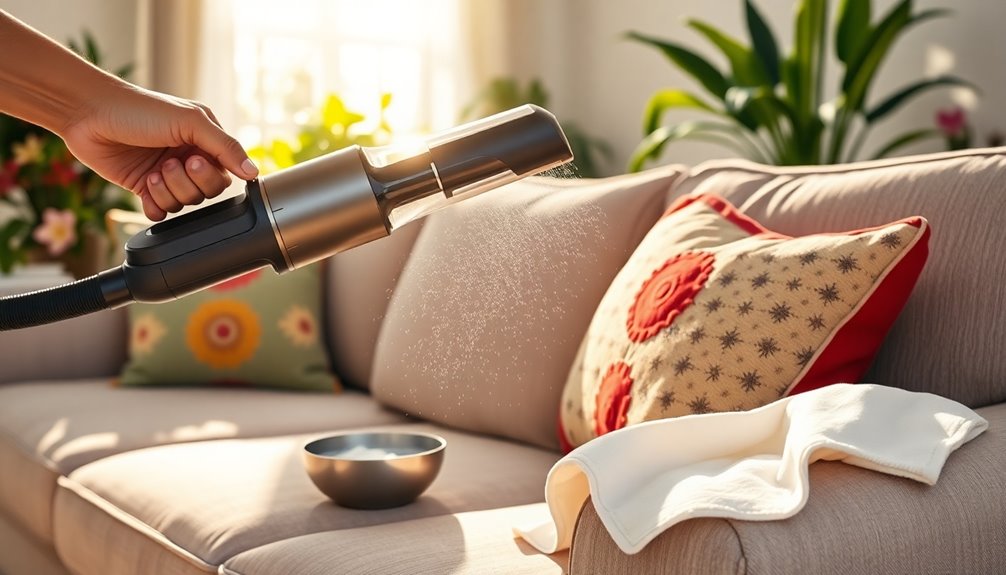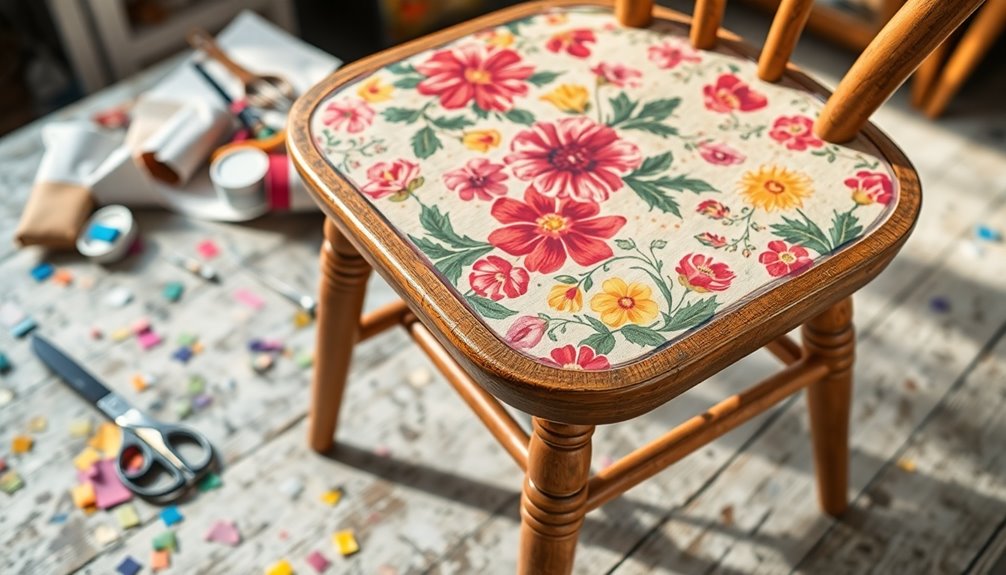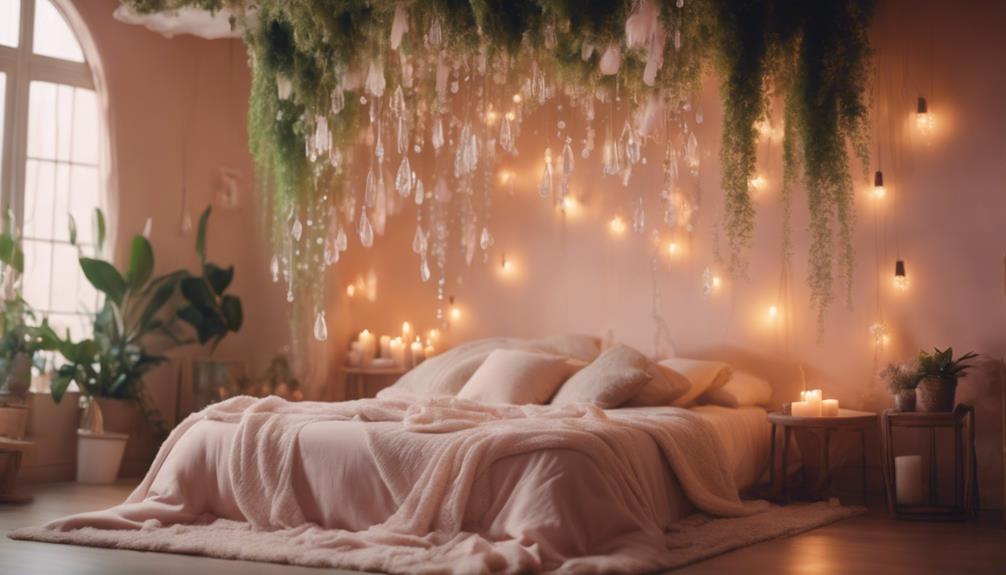To clean your velour sofa, start with weekly dusting and vacuuming using a soft brush attachment. Always vacuum in the direction of the nap to maintain its texture. For stains, blot immediately with a cloth and use a mild soap solution for gentle cleaning. Test any solution on a hidden area first. Avoid saturating the fabric, and let it air dry completely. Regular maintenance and seasonal deep cleaning keep your sofa looking luxurious. If you’re curious about additional tips and strategies for optimal care, there’s more to uncover that can help you enhance your cleaning routine. For those looking to expand their cleaning knowledge, exploring methods for cleaning faux suede furniture can be beneficial as well. Similar techniques apply, such as using a soft brush for dusting and a specialized cleaner to address any stains. Remember to always follow the manufacturer’s instructions to ensure you maintain the beauty and durability of your furniture while avoiding any damage.
Key Takeaways
- Regularly dust and vacuum your velour sofa using a soft brush attachment to remove dirt without damaging the fabric.
- Mix mild liquid soap with warm water for a gentle cleaning solution, and test on a hidden area first.
- Blot spills immediately with an absorbent cloth to prevent stains; avoid rubbing to minimize damage.
- Schedule professional cleaning every 6 to 12 months for deep cleaning and maintenance of the fabric.
- Use light steam application to restore the fabric's nap and eliminate creases, allowing it to air-dry completely.
Introduction
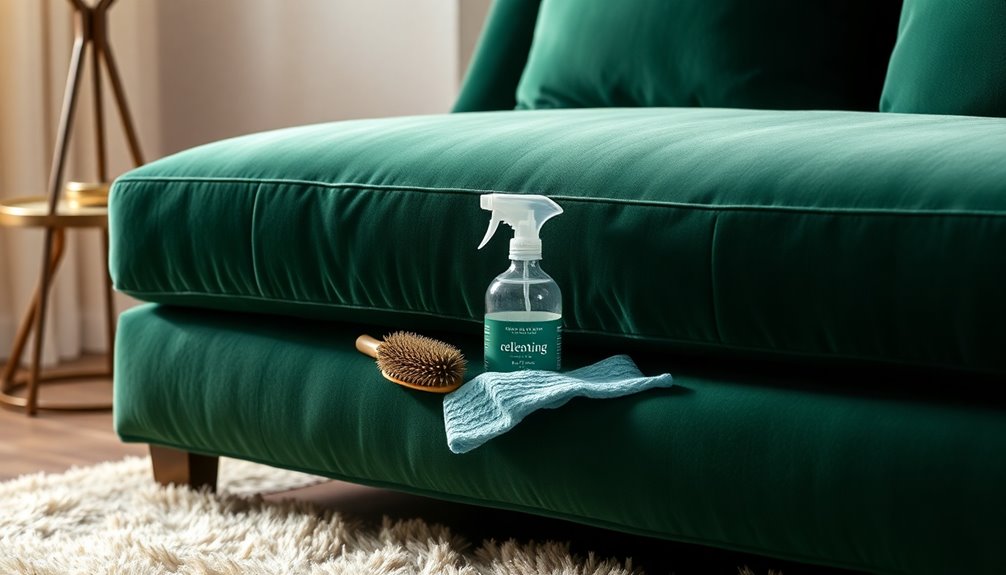
Keeping your velour sofa looking its best starts with regular dusting and vacuuming to prevent dirt buildup. You'll also need to use fabric-specific cleaning techniques for those inevitable spills, like wine and ink stains. With the right care, you can maintain the luxurious feel and appearance of your sofa for years to come.
Weekly Dusting and Vacuuming
To maintain the beauty and integrity of your velour sofa, regular dusting and vacuuming are essential practices. Aim to perform these tasks at least once a week to prevent dirt buildup and keep the fabric looking fresh. Start by using a vacuum cleaner equipped with a soft brush attachment. This tool is designed to gently remove dust and pet hair without damaging the delicate fibers of your sofa.
When vacuuming, always do so in the direction of the nap to avoid flattening those soft fibers. For stubborn dust or lint that the vacuum might miss, you can incorporate a soft bristle brush or a lint roller. These tools are effective at picking up particles that cling to the velour's texture.
Regular maintenance through weekly dusting and vacuuming not only preserves the velour's luxurious appearance but also helps prolong its lifespan by preventing wear and tear. By making these practices a part of your cleaning routine, you'll ensure your velour sofa remains a beautiful centerpiece in your home for years to come.
Fabric-Specific Cleaning Techniques
When it comes to cleaning your velour sofa, using fabric-specific techniques is crucial for maintaining its luxurious look and feel. Start with gentle cleaning methods to avoid damaging the delicate fibers of your upholstery. Use a soft brush to remove surface dirt before vacuuming. This step helps prevent any dirt from embedding deeper into the fabric.
For cleaning stains, mix a mild liquid soap with warm water to create a gentle cleaning solution. Always test this solution on a hidden area first to ensure it won't discolor your velvet. When spot cleaning, act quickly: blot spills immediately with a clean, absorbent cloth, and use a back-and-forth motion to apply your cleaning solution. Avoid rubbing, as this could damage the texture of the fabric.
Regular vacuuming with an upholstery attachment is essential for keeping your velour sofa looking its best. Additionally, consider scheduling professional cleaning periodically to preserve its softness and appearance. By following these fabric-specific cleaning techniques, you'll keep your velour sofa in pristine condition, ready for relaxation and entertaining.
Treating Wine and Ink Stains
Stains from wine or ink can be particularly daunting, but quick action can make a significant difference in preserving your velour sofa. For wine stains, start by gently blotting the area with a clean, absorbent cloth to soak up excess liquid. Avoid rubbing, as this can spread the stain. Once you've blotted, mix a mild dish soap with water and use a damp cloth to gently blot the stained area. Rinse with another damp cloth to remove any soap residue.
When dealing with ink stains, apply a small amount of rubbing alcohol to a cotton ball and carefully dab the area. Make sure not to saturate the fabric, as this can lead to further damage. Always test any cleaning solution on an inconspicuous part of the velour sofa to prevent discoloration.
After treating either type of stain, let the area air dry completely. Once dry, gently brush the fabric in the direction of the nap to restore its texture. These steps will help you effectively clean a velvet couch and keep it looking its best, even after pesky stains.
Shield From Pet Claws
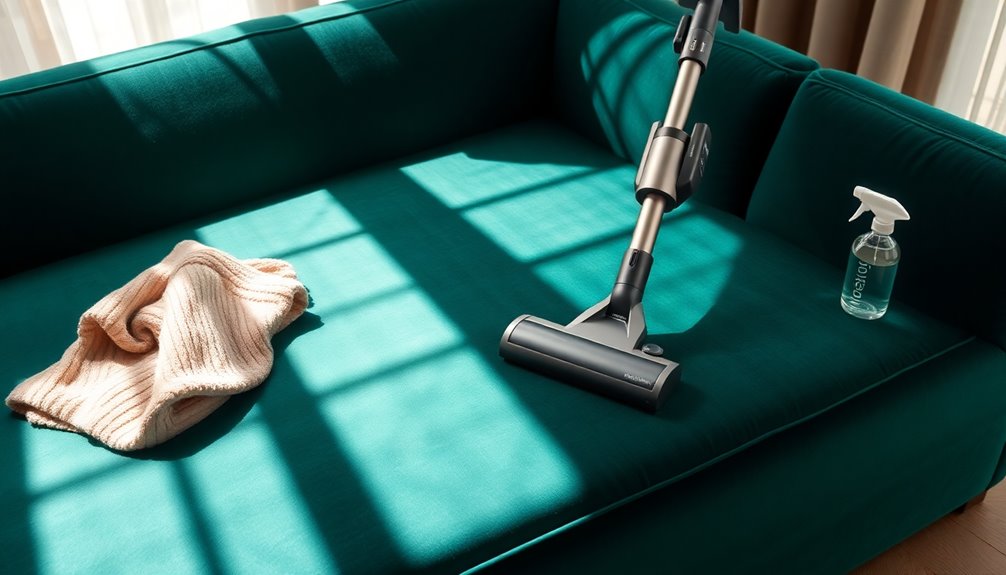
To protect your velour sofa from pet claws, you can explore claw-resistant fabric options that offer enhanced durability. Additionally, decorative fabric protection options not only safeguard your furniture but also maintain its stylish appearance. Minimizing friction on the fabric is key, so consider how your pets interact with the sofa to reduce wear and tear.
Claw-Resistant Fabric Options
Choosing the right fabric for your velour sofa can make all the difference in protecting it from pet claws. Consider opting for synthetic velvet fabrics, which are generally more durable and resistant to claw damage than natural fibers. Look for options with a high Martindale rub count of 40,000 or more; these fabrics offer greater resilience against wear and tear from your pets.
Micro velvet and performance velvet are excellent choices, as their tighter weaves help prevent snagging and pulling from claws. Additionally, some manufacturers provide specialized pet-friendly upholstery featuring reinforced fibers designed to withstand scratches and punctures. These fabrics can significantly extend the life of your sofa.
Regular maintenance is key to keeping your sofa looking its best. Vacuuming regularly removes pet hair and debris, while brushing the fabric helps maintain its integrity, minimizing the impact of claw damage over time. By incorporating these cleaning methods into your routine, you'll enhance the longevity of your sofa while ensuring it remains a comfortable spot for you and your pets. Choose wisely, and enjoy a beautiful, claw-resistant velour sofa!
Decorative Fabric Protection Options
A variety of decorative fabric protection options can help shield your velour sofa from pet claws while enhancing its overall appearance. Start by applying a fabric protector specifically designed for velour. This creates a barrier against damage and increases the fabric's durability. Look for products that are water-repellent and stain-resistant to prevent spills and minimize pet-related stains.
Using slipcovers made from durable, pet-friendly materials offers an additional protective layer while maintaining your living space's aesthetic. Regularly brushing the velour with a soft brush can lift the nap and reduce the visibility of scratches from your furry friends.
Incorporating throw blankets or cushions that can be easily cleaned or replaced is another great strategy. These not only safeguard your velour sofa but also allow you to enjoy the luxurious feel of the fabric without constant worry. Choose decorative fabric that complements your home's style while ensuring it's functional for pet owners. By combining these protective measures, you can keep your velour sofa looking beautiful and extend its life, all while accommodating your beloved pets.
Minimize Friction on Fabric
Protecting your velour sofa from pet claws is key to maintaining its beauty and longevity. To minimize friction on the fabric, consider using a protective cover or throw. This barrier can help keep direct contact to a minimum. Regularly trimming your pet's nails is also essential; shorter nails mean less chance of snagging the velour surface.
Designate specific areas for your pets to sit or lie down, limiting their access to the sofa. This helps reduce wear and tear on the fabric over time. Additionally, utilize pet-friendly cleaning products or fabric protectors designed for velour. These create an extra layer of protection against claws and spills, making it easier to remove stains when they occur.
Establish a routine for brushing your pets regularly to minimize shedding and dust buildup on the velour. Keeping the fabric clean and free from debris also lowers the friction that can lead to damage. With these simple care tips, you can ensure your velour sofa remains a beautiful and comfortable spot for both you and your furry friends.
Upholstery Stitching Reinforcement
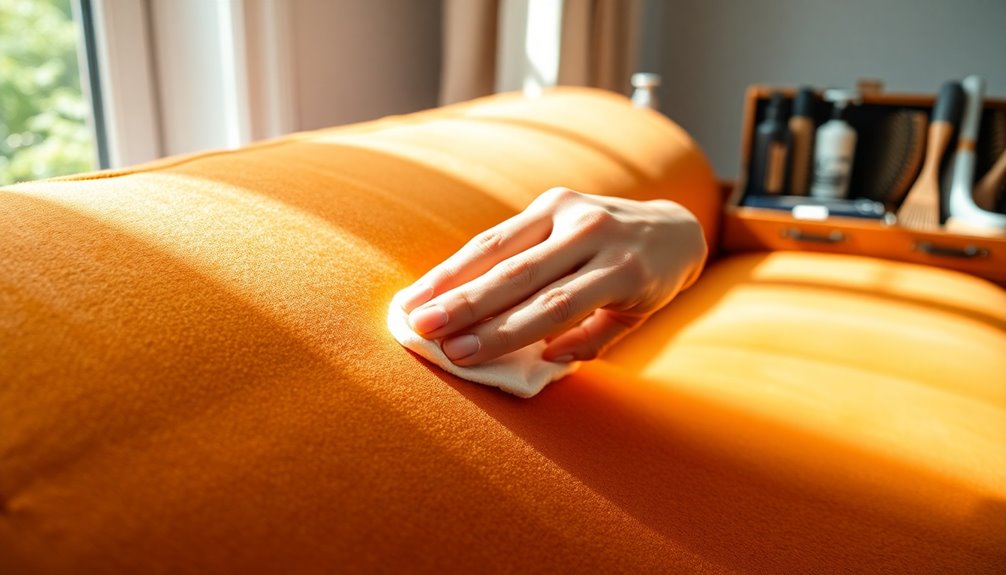
When it comes to maintaining your velour sofa, paying attention to upholstery stitching reinforcement is key. Strong seams not only keep the fabric intact but also enhance the overall aesthetic appeal and longevity of your furniture. By ensuring sewn seam integrity, you can effectively address upholstery color repair techniques and keep your sofa looking revitalized and stylish.
Sewn Seam Integrity
Sewn seam integrity is essential for maintaining the durability and beauty of your velour sofa. Properly sewn seams reinforce the fabric, preventing fraying and unraveling over time. High-quality upholstery stitching typically employs double-stitched or reinforced seams that can handle regular use without compromising their integrity.
To ensure your sofa remains long-lasting, regularly inspect the sewn seams for any signs of wear or loosening. Catching these issues early allows for timely repairs, preventing more extensive damage that could affect the overall appearance of your sofa. When making repairs, always use strong, colorfast thread that matches your velour fabric. This not only maintains aesthetic appeal but also provides the necessary structural support.
Compromised seams can lead to fabric pulling and bulging, resulting in costly repairs and a diminished look. By maintaining sewn seam integrity, you enhance the durability and longevity of your velour sofa, keeping it looking and feeling its best. Remember, taking care of your upholstery stitching now will save you headaches in the future, ensuring your sofa remains a beautiful centerpiece in your home for years to come. Additionally, incorporating a budget-friendly home appliance maintenance plan can help ensure that any necessary cleaning tools are well-maintained and ready for use.
Upholstery Color Repair Techniques
How can you ensure your velour sofa maintains its vibrant look over time? One crucial step is upholstery stitching reinforcement. This technique is essential for preserving the integrity of your sofa, especially in high-use areas that face wear and tear. Regularly inspect seams and stitching for signs of fraying or separation. If you notice any issues, address them promptly to prevent further damage.
When performing stitching repairs, use a heavy-duty needle and upholstery thread that matches your velvet fabric. This ensures durability and a seamless appearance. For added strength, consider employing cross-stitch or double stitch techniques in areas that experience significant stress. This will enhance the longevity of your upholstery.
As you reinforce the stitching, make sure the fabric is taut and flat. Avoid puckering, as it can detract from the overall aesthetic of your velour sofa. If you're unsure or uncomfortable with any of these repair techniques, don't hesitate to seek professional help. Following these cleaning instructions and repair tips will keep your sofa looking fresh and vibrant for years to come.
Revitalizing Softness and Style
To keep your velour sofa looking and feeling its best, it's essential to focus on revitalizing its softness and style. Start by regularly brushing the fabric with a soft bristle brush, making sure to brush in the direction of the pile. This simple velvet cleaning technique lifts dirt and helps restore that luxurious texture you love.
Next, check the upholstery stitching for any fraying or loose threads. Reinforcing these seams is crucial to prevent further damage and maintain your sofa's overall appearance. If the fibers seem a bit flat, using a steamer on low heat can gently revive them, improving the plush feel and restoring the fabric's original shape.
After cleaning, apply a fabric protector specifically designed for velour. This step safeguards against future stains and wear, allowing you to maintain both softness and aesthetic appeal. Additionally, regularly rotate and flip your cushions to distribute wear evenly. This practice not only enhances comfort but also helps preserve your sofa's style over time. By following these steps, you'll keep your velour sofa looking fabulous and feeling soft for years to come. Consider using a robot vacuum cleaner to help maintain cleanliness and reduce manual cleaning effort.
Personalized Fabric Treatments
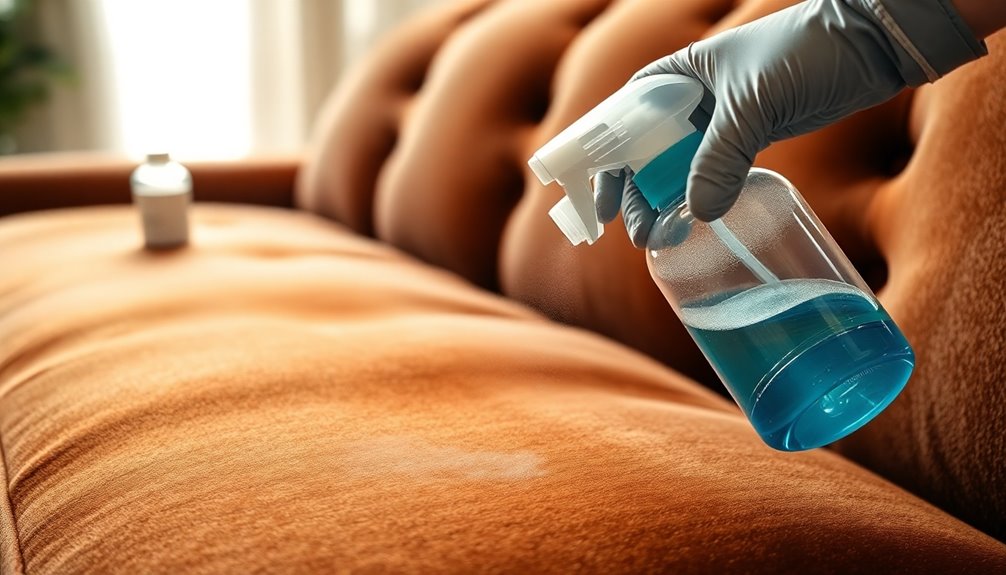
When it comes to caring for your velour sofa, personalized fabric treatments can make a significant difference in maintaining its beauty and functionality. These treatments enhance stain resistance, making it easier to clean up spills and reducing the chances of permanent marks. To keep the softness and appearance of your velour intact, consider selecting a fabric protector specifically designed for this material.
Using a pH-balanced cleaning solution tailored for delicate fabrics ensures you can effectively clean without damaging the velour. Regularly applying a specialized upholstery cleaning spray not only maintains the look of your sofa but also helps prevent grime buildup and prolongs its life.
Before fully applying any personalized fabric treatments, always test them on a small, inconspicuous area. This precaution prevents unwanted discoloration or damage to your velour. By incorporating these personalized treatments into your cleaning routine, you can effectively shield your sofa from dirt and moisture while preserving its luxurious texture. Your velour sofa deserves the best care, and these steps will help you achieve that effortlessly.
Seasonal Deep Cleaning Guidelines
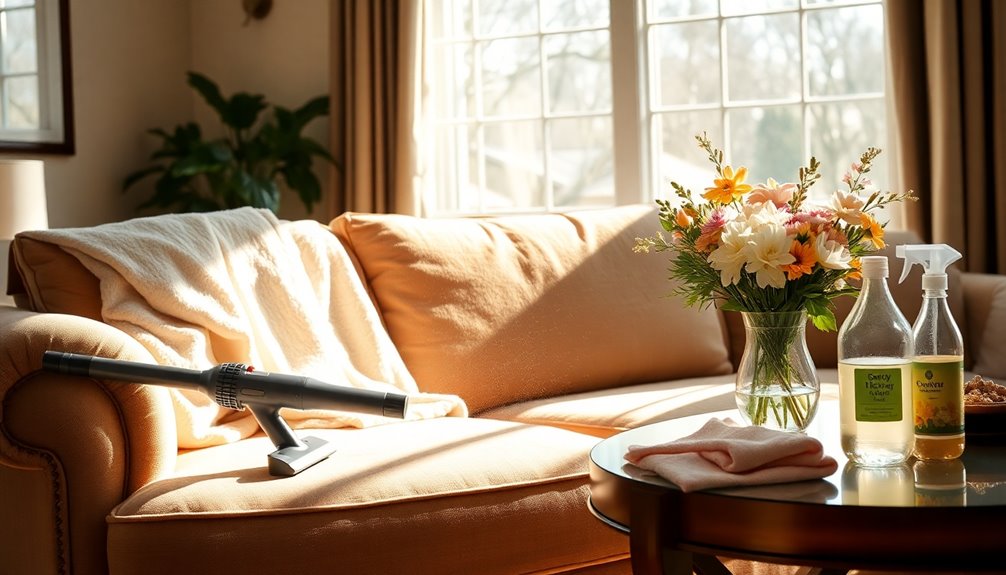
Regularly conducting a seasonal deep cleaning is essential for keeping your velour sofa looking its best and ensuring its longevity. Aim to deep clean every 6 to 12 months, adjusting the frequency based on how much you use the sofa and its exposure to dust and dirt.
Start by using a vacuum cleaner equipped with a soft brush attachment. This helps you thoroughly remove dust and debris, focusing on seams and crevices where dirt tends to accumulate. Next, prepare a cleaning solution by mixing mild liquid soap with warm water. Make sure it's free of additives or colors. Using a damp cloth, apply this solution in a back-and-forth motion to clean the fabric gently.
Once you've cleaned the sofa, use the steam setting on your steamer, applying it lightly to the velour surface. This step helps restore the fabric's nap and eliminates any creases or impressions. Finally, allow your sofa to air-dry completely before using it again. This prevents moisture-related damage, ensuring your velour sofa remains in pristine condition for years to come.
Conclusion
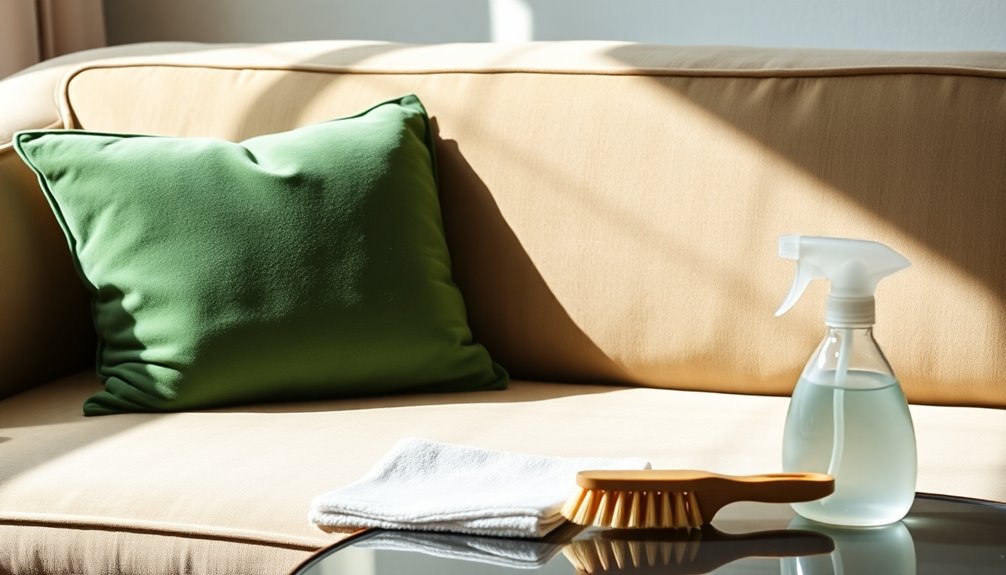
Maintaining your velour sofa through regular cleaning and care not only enhances its appearance but also extends its lifespan. By vacuuming weekly with a soft brush attachment, you can effectively prevent dust and dirt buildup. When spills occur, act quickly by blotting with an absorbent cloth to prevent stains from setting in. For everyday cleaning, a solution of warm water and mild liquid soap works wonders—just apply it with a damp cloth and ensure you let the fabric air dry afterward to maintain its integrity.
To keep your sofa looking plush, consider steaming it on a low setting; this technique can help restore its plush appearance and remove any creases without causing damage. For those tough stains or heavily soiled areas, don't hesitate to seek professional cleaning. These experts can ensure your velour sofa remains in excellent condition while preserving its delicate fabric. Remember, regular maintenance is key to enjoying your beautiful velour sofa for years to come. By following these simple steps, you'll not only clean your velvet but also enhance its longevity and comfort, making it a cozy spot in your home.
Frequently Asked Questions
What Is the Best Way to Clean a Velour Sofa?
To keep your velour sofa looking great, start by brushing the surface with a soft brush to get rid of dirt and lint. Then, vacuum with a soft attachment. Mix mild soap with warm water, blotting stains gently with a damp cloth. For oily spots, sprinkle cornstarch, let it sit, and vacuum. Always test any cleaning solution on a hidden area first, and remember to vacuum weekly to maintain its appearance.
Is a Velour Sofa Easy to Clean?
Yes, a velour sofa's pretty easy to clean. Its synthetic fibers resist stains better than natural ones, which makes maintenance simpler. Regularly vacuuming with a soft brush attachment helps keep dust and dirt at bay. If you spill something, blot it immediately with an absorbent cloth to avoid stains. For deeper cleaning, consider professional services every couple of years, especially if you have pets or use it heavily.
How Do You Get Stains Out of Velour Fabric?
To get stains out of velour fabric, start by blotting spills immediately with an absorbent cloth—don't rub! For oily stains, sprinkle cornstarch or talcum powder and let it sit for several hours. Mix a mild solution of warm water and liquid soap, applying the suds gently with a damp cloth. Always test any cleaning solution on a hidden area first to avoid discoloration. For tough stains, consider hydrogen peroxide, but remember to test it too!
How Do You Clean Velour Seats?
To clean velour seats, start by using a soft brush to gently remove any surface dirt. After that, vacuum the seats to eliminate loose dust. Next, mix mild soap with warm water, avoiding suds, and apply it with a damp cloth in a back-and-forth motion. If you spill something, blot it immediately with an absorbent cloth. Regularly vacuum with a brush attachment to keep the fabric looking fresh and fluffy.


